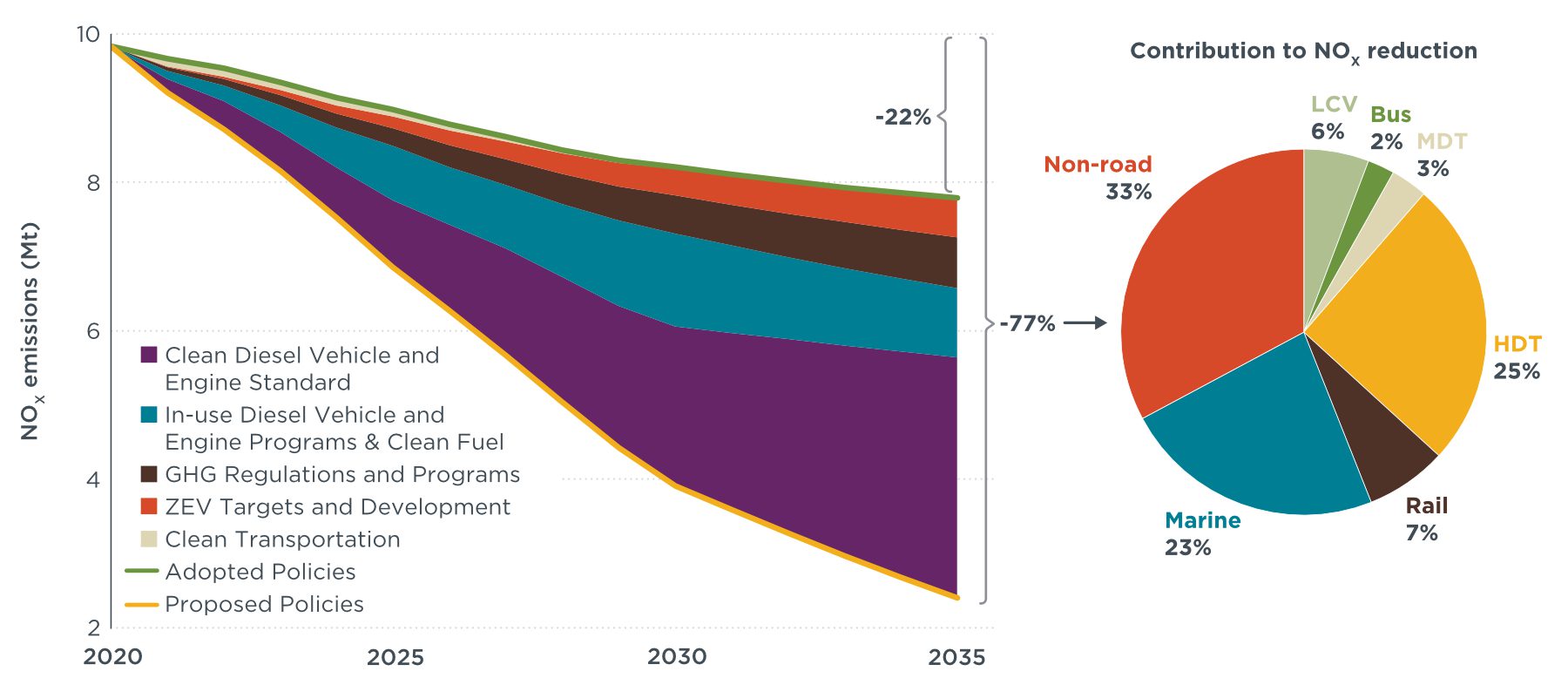Blog
China’s chance to further reduce diesel emissions with robust policy “punches”
Doing more to abate emissions from diesel fleets can be one of the most critical missions for China in the next decade. The China Mobile Source Environmental Management Annual Report, published by the Ministry of Ecology and Environment (MEE), revealed that on-road vehicles emitted 5.82 Mt of nitrogen oxides (NOx) and 69 kt of particulate matter (PM) in 2021, the vast majority from diesel vehicles. That same year, non-road diesel vehicles and equipment contributed similar NOx emissions of 4.79 Mt and much higher PM emissions, 234 kt. From this it’s clear that both on-road and non-road sources of emissions need to be addressed.
Over the past few years, ICCT has reviewed the best clean diesel programs in China and the historical policy practices in California, a world leader in diesel emission control policies. Just recently, we published a paper that identified a suite of robust clean diesel “punches” for China to consider in roughly the next 10 to 15 years. These are diesel emission reduction strategies that focus on five major policy areas and cover emissions from four sectors: on-road commercial vehicles, non-road machinery, rail, and marine.
With the ICCT’s Roadmap model, we evaluated the benefits of such policies until 2035 under a Proposed Policies scenario and compared them to an Adopted Policies scenario, which represents policy measures and associated clean technologies adopted in China as of October 2022. Figures 1 and 2 show the estimated NOx and PM emissions trends from 2020 to 2035, including the contributions from each policy category and by sector in the Proposed Policies scenario. We found that by the end of 2035, much higher NOx and PM emissions abatement can be achieved under the Proposed Policies scenario: 77% and 73% reductions, respectively, compared with 2020. There are only reductions of 22% for NOx and 17% for PM under the Adopted Policies scenario.

Figure 1. NOx emissions reduction under the Adopted Policies and Proposed Policies scenarios by policy category, 2020–2035, and reduction contribution by sector in 2035 under the Proposed Policies scenario.

Figure 2. PM emissions reduction under the Adopted Policies and Proposed Policies scenarios by policy category, 2020–2035, and reduction contributions by sector in 2035 under the Proposed Policies scenario
The “punches” in the Proposed Policies scenario are enough to eliminate 8.7 Mt of NOx emissions and 437 kt of PM emissions in 2035 and to pull back the NOx and PM emission increases from the rail and marine sectors that are expected in 2035 under the Adopted Policies scenario (see Figure 6 in the paper). This clearly shows the potential of policy measures beyond those currently in place. Here are some of the key suggested policies:
- Tighten emission standards for new diesel vehicles and engines, including Euro 7 equivalent for on-road in 2025, Euro VI equivalent for non-road in 2027, and Euro V equivalent for marine and locomotive engines.
- Fully utilize a variety of technologies, including remote sensing monitoring and remote on-board diagnostics, to improve supervision of vehicles and compliance with emission standards.
- Promote control measures by accelerating the phase-out of old vehicles and engines, incentivizing multi-modal freight transportation, and implementing stringent inspection and regulations for in-use compliance.
- Develop zero-emission sales targets and incentive policies to promote zero-emission vehicles (ZEVs) and engines. For example, in 2030, a target for new sales of on-road commercial vehicles could be 50% zero-emission, and that same percentage could be 90% for freight rail and 35% for non-road machines; new forklifts would be capable of being 100% zero-emission. With respect to ocean-going vessels, a target could be to equip 8% of these with shore power connection by 2030.
- Integrate control of greenhouse gas emissions with control of criteria air pollutants in the next stage of emission standards, and regulate limits on CO2, methane, nitrous oxide, and hydrofluorocarbons.
Insights by policy category and sector
The clean diesel vehicle and engine standards for new vehicles, a category that includes things like introducing China VII emission standards, is the most powerful of the policy categories for reducing NOx emissions and contributes nearly 60% of the reductions in 2035. The in-use vehicle and clean fuel category comes in second with a 15% contribution to NOx emissions reduction. Meanwhile, for PM reduction, policies in the in-use vehicle and fuel category, including accelerated retirement of old vehicles and replacement or retrofitting of high-emissions machinery, is the most effective and accounts for 50% of total PM reduction.
The ZEV targets and GHG regulations categories, which include things like ZEV sales targets and stringent fuel efficiency standards, respectively, showed great co-benefits for both NOx and PM emissions control all the way through to 2035, together contributing about 25% of the NOx reductions and about 45% of the PM reductions. The clean transportation category, which includes things like specific freight activity transferred from on-road to rail, would work most effectively in the first 5 years.
When looking at the sector level, we see that non-road machinery and marine vessels have the potential to contribute 33% and 23% of the total NOx emissions reduction, respectively. Additionally, non-road machinery can bring PM reductions of 37% and marine vessels can bring 39%, both of which are much higher than the PM reduction from on-road vehicles, which is 20%.
Several of ICCT’s policy recommendations for managing emissions from on-road sources were reflected in China’s Action Plan for the Battle Against Diesel Truck Pollution, released November 10, 2022. This can be considered the second phase of China’s Clean Diesel Action Plan and it will bring clear benefits. However, as demonstrated here, additional policies could be considered to specifically control NOx and PM emissions, and it is possible to accelerate the development of policy measures for non-road machinery and marine vessels to yield even greater benefits.
